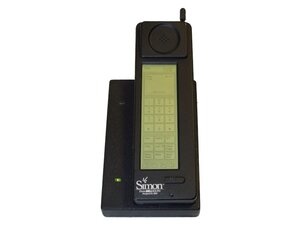crwdns2944766:0crwdne2944766:0
crwdns2918718:0crwdne2918718:0crwdns2935091:0crwdnd2935091:0crwdne2935091:0
crwdns2916646:0crwdne2916646:0
Background Information
Announced on November 2, 1993, and released on August 16, 1994, the IBM Simon was a cellular phone and PDA combination designed by IBM. While the Simon was characterised as a PDA with cellular communication capabilities, it is widely regarded as one of the first “smartphones" before the term existed.
Device History
1992 First Public Appearance
The development of the Simon started between August 1992 and November 1992, and was initially intended to be a proof of concept for what future mobile devices could be capable of. The Simon was publicly demonstrated during the 1992 Comdex expo by designer Frank J. Canova under the name "Sweetspot" and was known as a "Personal Communicator" during the demo, since the term smartphone was not yet known.
The primary success of the Simon was the compact and personal touchscreen, which enabled users to communicate both verbally and through data. This design aimed to foster a more intuitive interaction, as the touchscreen would display familiar buttons akin to those found on a phone, rather than a keyboard with a DOS interface.
1993 First Commercial Smartphone Announced
Development of the Simon continued into 1993 after the telecommunications holding company BellSouth became interested in Simon after seeing it at the 1992 Comdex expo, and on November 2, 1993, the Simon was announced by BellSouth's vice president of marketing, Jim Thorpe. The original plan was for BellSouth to begin selling the Simon in May 1994; however, due to problems stemming from the Simon's cellular faxing capabilities, release was pushed back to August of the same year.
1994 Release
On August 16, 1994, BellSouth Cellular commenced selling the Simon phone to consumers across its 15-state service area. The phone was priced at $899, accompanied by a two-year service contract, or at $1099 without a service contract.
1995 Discontinuation
BellSouth, a mobile phone service provider, was discontinued in February 1995, just six months after its initial launch. During its brief existence, BellSouth managed to sell only 50,000 units. Users reported several issues with the service, including poor battery life, a bulky design, and limited network coverage.
Technical Specifications
General Information
- Brand: BellSouth (Designed by IBM)
- Developer: IBM
- Designer: Frank James Canova Jr.
- Manufacturer: Mitsubisi Electric Corp.
- Type: PDA w/ Cellular Communication Capabilities (Smartphone)
- Availability: August 16, 1994
- Discontinued: Febuary 1995
- Units Sold: 50,000
- Unit Cost:
- $899 w/ contract ($1,970.28 in 2025)
- $1099 wo/ contract ($2,408.60 in 2025)
Software
- Operating System: Datalight ROM-DOS
- Features:
- Phone
- Fax
- Calendar
- PIN Functions DOS Based w/ Navigator Shell
Display
- Size: 4.5 in x 1.4 in (114 mm x 36 mm)
- Type: CGA Monochrome Backlit LCD
- Resolution: 160 x 293
Chipset Information
- CPU: Custom 80C86 - Single Chip
- Memory:
- 1 MB PSRAM (2 x Hitachi HM658512LTT)
- 32 KB ROM (Sony CXK58257)
- Storage: 1 MB NOR Flash (Intel/Hitachi) expanded to 2 MB by Stacker compression+ 32 KB BIOS NOR Flash
- Expandable Storage: Optional PCMCIA Flash RAM Cards
Power
- Battery Type: Rechargable Ni-CAD Clip on Pack
- Capacity: 7.5V
- Battery Backup: Lithium Coin
I/O
- Screen:
- Resistive APA Film (Touch & Stylus) Inking
- Pointing Via Pen
- Slots: PCMCIA Type 1/2 Slot V2.0
- Modem: V.22 Data & Full G3 Send/ReceiveFax (V.29, V.27ter)
- Ports: 33 Pin Connector (RJ-11, RS-232)
Physical Dimensions
- Length: 8 in (22 mm)
- Width: 2.5 in (64 mm)
- Height: 1.5 in (38 mm)
- Weight: 18 oz (510 g)
Optional Accessories
- Standard Battery
- High Capacity Battery
- Sequential Charger
- Stylus Set
- PCMCIA Pager
- Standard Telephone Connection
- 1.8 MB Memory Card
- 1 MB Memory Card
- Cigarette Lighter Charger Adapter


